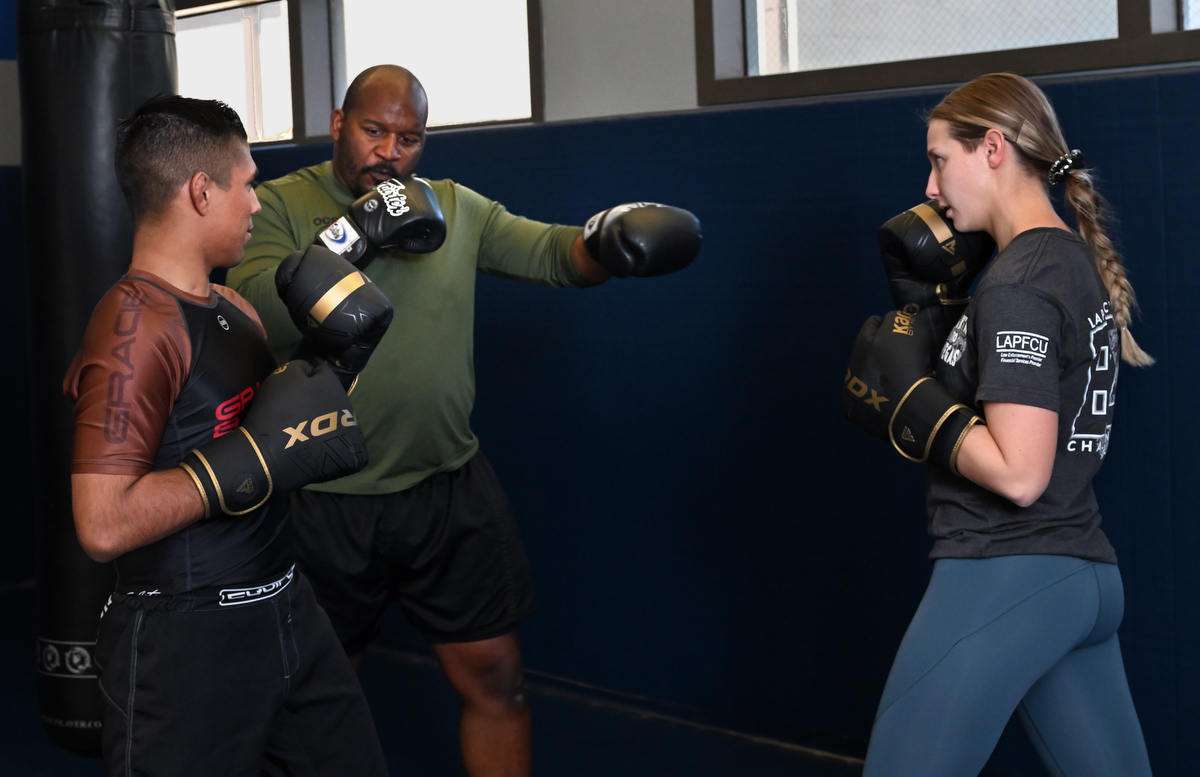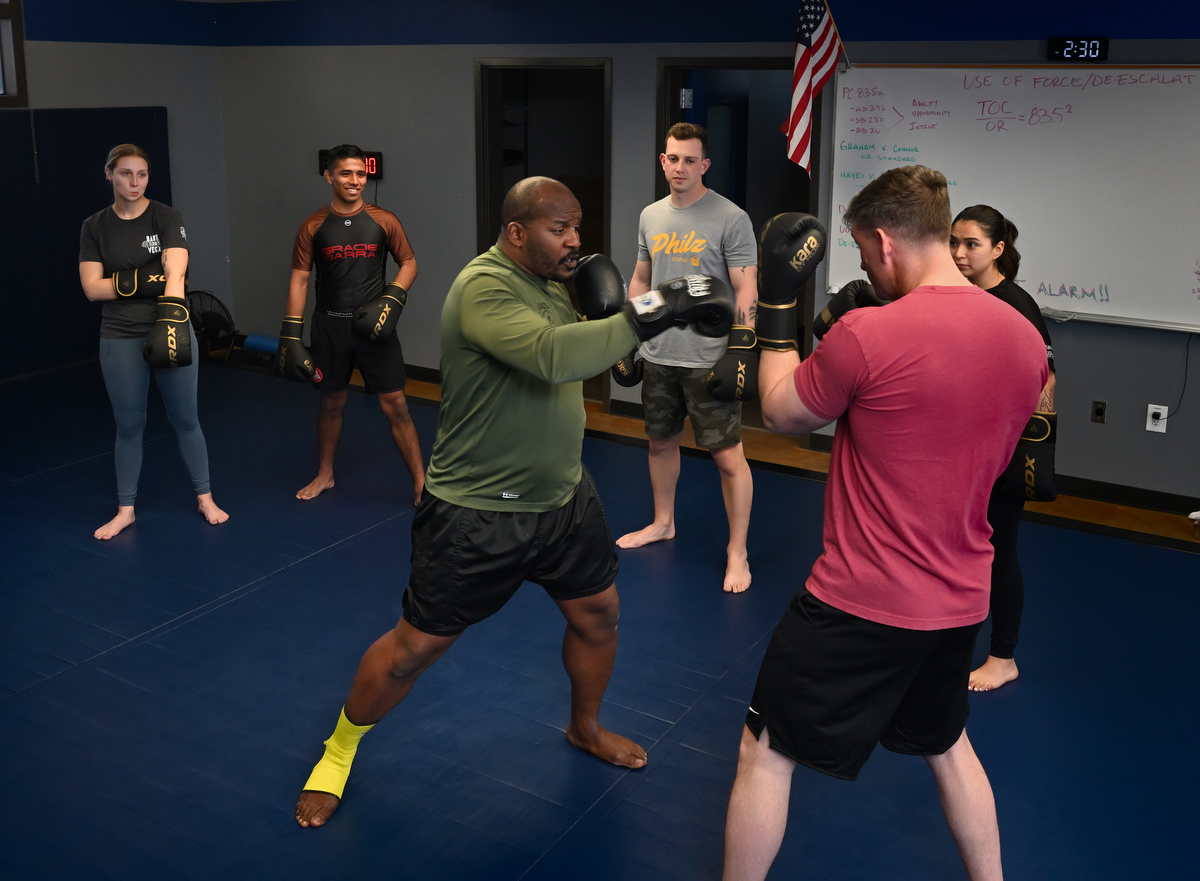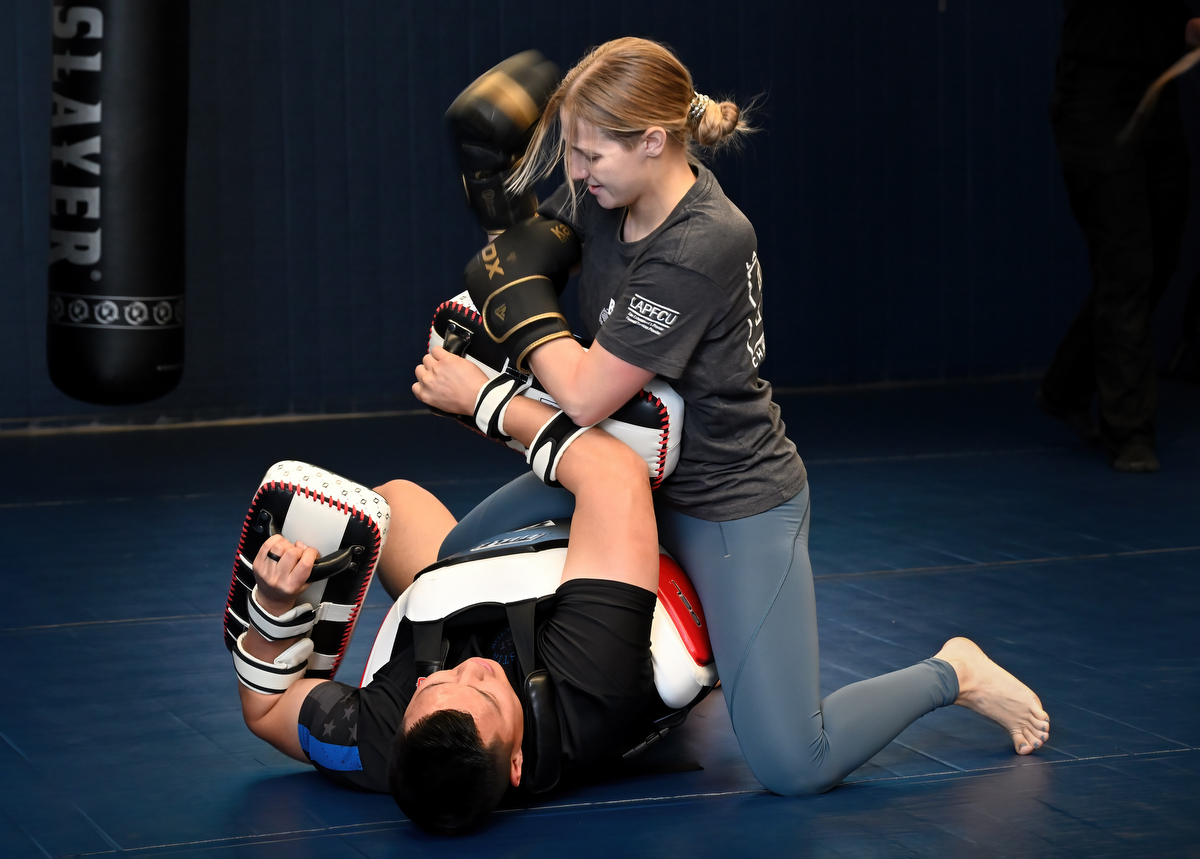A would-be assailant throws a punch.
With a slip of the hips and head, Jason Moreno slides under the punch, takes the attacker’s free wrist, steps through and behind his opponent, and easily takes him to the ground while maintaining control of the altercation.
Moreno, a brown belt in the martial art of jiu-jitsu, is a 20-year-old Cadet at the Tustin Police Department who hopes to become a police officer with the agency. He took up the sport six years ago to recuperate from illness and rebuild his cardiovascular health. He now helps teach officers about the form of the combat fighting sport that, literally, translates to “the gentle art.”
Jiu-jitsu (the most common version in the U.S. is Brazilian jiu-jitsu) holds a special appeal that police departments across the country are beginning to embrace.
“You’re able to subdue a suspect and you don’t have to cause injuries,” said Sgt. Royce Del Merari.

Jason Moreno, left, spars with Jessica Helmick of Tustin Police Department during a use of jiu-jitsu training session.
Photo by Steven Georges/Behind the Badge
“It doesn’t have a lot of striking,” said Sgt. Gus Gonzalez, who is a three-stripe purple belt in jiu-jitsu and has trained for eight years. “You manipulate leverage. It’s not seen as a brutal martial art.”
For Moreno, who is fit but not physically imposing, jiu-jitsu allows him to remain calm even as tensions and the threat of physical confrontation rise.
“It gave me a good confidence,” he said. “I know how to protect myself.”
Del Merari, who has been training in the sport for a year, agrees.
“You have more of a sense of calm assurance,” he says. “One of the principles is you don’t fight unless you have to.”
Rather than looking to unleash newfound skills, Del Merari says jiu-jitsu has had an opposite effect on his policing.
“The difference is 100 percent,” Del Merari said. “I will stare at someone, as calm as I can be.”
Earlier in his career Del Merari might have been more impatient and tempted to speed along the process when an arrest or force seemed inevitable. Now, he says, “It’s like an inner calm. I’m more willing to tolerate verbal abuse.”

A jiu-jitsu training session for Tustin Police Department personnel.
Photo by Steven Georges/Behind the Badge
Violence and harm reduction
The gentle nickname for the sport, although it’s a little misleading, comes from the fact that it’s all about neutralizing and negating attacks. Through jiu-jitsu, combat can be transferred into something more like choreography. The sport is about physics and technique. Jiu-jitsu takes the energy from the attacker and, in theory, allows a smaller, weaker person to use leverage and body mechanics to control a stronger, larger aggressor.
With his step-through, Moreno dissipated the energy and took the balance from his attacker. He needs only gravity to put the assailant down. From there, through various techniques, he can take a controlling position and either wait for assistance, or continue to subdue and eventually hand-cuff and arrest the suspect.
Later in the training session, at a mat room at The Annex at Tustin Legacy, Moreno demonstrates how a kimura grip technique can be used to control attackers’ wrists so they can be hand-cuffed.
Ever since the beating of Rodney King and, more recently, the vicious videotaped death of Tyre Nichols at the hands of Memphis police, the public has been appalled by uses of force that devolve into violence.
Del Merari said often the most violent altercations occur when the officer is insufficiently trained and unable to control a suspect. For police, jiu-jitsu and other grappling sports can be — and are becoming — an invaluable alternative in physical struggles by removing striking, clubbing, kicking and elbowing.
“It’s less graphic for the public,” Gonzalez said. “An officer can be confident in his ability to keep a subject under control on the ground.”
Research indicates that using jiu-jitsu reduces injuries to both officers and assailants, and can prevent the need to use potential deadly force.
The Marietta example
A small Georgia police agency has been at the forefront of the jiu-jitsu training movement since 2019. That’s when a viral video showed several of the town officers striking a man multiple times while attempting to take him into custody. Soon after, the department implemented a mandatory jiu-jitsu program to train officers and personnel in methods to “establish a safer custodial environment for both officers and arrestees,” according to the department.
Since then, other agencies have followed suit. The Georgia Peace Officer Standards and Training Council, the state’s certification agency, voted to move forward with approving the Marietta model as a police training program for the entire state. Similarly, a Michigan police reform bill would require police to be trained in jiu-jitsu or other grappling.
Before Georgia took the spotlight, the St. Paul Police Department began offering jiu-jitsu training in 2015 and reported that police use of force dropped 37 percent, injuries to suspects dropped 44 percent, and officer injuries dropped 25 percent, department statistics showed.
Major Jake King in Marietta, who oversees the jiu-jitsu program there, has even more startling stats.
In a podcast interview, King said the number of officers injured attempting arrests before the program fell from 29 to 15 in the 18 months before the program compared to the same time frame after. Moreover, none of the officers who took the training were injured.
Departments can also enroll in a program called Gracie Survival Tactics (GST). The Gracies are a family of experts in Brazilian jiu-jitsu who have become synonymous with the sport in the U.S. with gyms across the country.
The GST program is specially designed for law enforcement and police techniques designed to help officers prevail against larger and stronger opponents.
Critics say jiu-jitsu is not a panacea, but could be part of more holistic approaches to policing. There are also those who worry that certain holds learned in jiu-jitsu, such as the rear naked choke and carotid restraint, can be lethal. In California, such holds are banned.
However, Del Merari notes that part of the problem is that the holds are only dangerous if incorrectly applied.
From cadet to cop
Moreno trains at the Gracie Barra Academy in Santa Ana, where he works out and teaches kids and adults.
Gonzalez not only trains at the academy, but brought his children in for training. The Tustin sergeant and Moreno had seen each other around the gym and had trained together. When Moreno began teaching Gonzalez’s children, they formed a parent-teacher friendship. Before Moreno knew Gonzalez’s line of work, he admired the man.
“You could tell that whatever he did, he was great at it and he was satisfied,” Moreno said of the vibe he got from Gonzalez. “It was just his character.”
When Moreno learned of Gonzalez’s job, he became intrigued by police work.
“I told him ‘Hey, man, it would be great to pursue,’” Gonzalez said. “I told him he had the commitment and good character and to apply.”
Gonzalez said Moreno is a good teacher and relates well with others. Although Moreno was not hired the first time he applied, in March he was accepted. Moreno is a graduate of Garden Grove High and currently studies computer science at Santa Ana City College.
He said he hopes to attend Police Academy as a Tustin recruit when an opportunity opens.

Jessica Helmick of Tustin Police Department spars with a partner during a jiu-jitsu training for Tustin personnel.
Photo by Steven Georges/Behind the Badge
In the mat room
Once a month, officers from the Tustin Police Department are invited to gather for Arrest and Control Technique (ACT) training and workout sessions. In addition to learning grappling techniques, the officers are also trained on more aggressive fighting styles, should they be required. They also hold a discussion on de-escalation tactics, types of force, legal developments, circumstances when force is allowed, and how to report use of force situations.
The ACT program was implemented in July 2022, and, according to Gonzalez, is growing in popularity. The program is offered on the first Wednesday of the month on a voluntary basis for about two hours and fulfills POST (Police Officers Standards and Training) requirements for eight hours of use of force training every two years.
The hope is that officers will “get the bug,” as Del Merari did a year ago, and begin training on their own at local academies and gyms. In addition to grappling, officers also learn striking techniques from disciplines such as boxing and Muay Thai.
“We take what works for us and incorporate it,” Gonzalez said.
At a recent training session, Officer Javon Smith, one of 12 instructors available to the classes, takes officers through a more traditional regimen with kicks, punches, spinning backfists and elbows. Despite the different techniques, Smith said martial arts training is about much more than winning fights.
Training is about “being able to think clearly in high stress situations,” he said. “The more training you have, the less likely you’ll get into a use of force situation.”
Gonzalez sees the program paying dividends.
“We are getting more buy-in,” he said. “It’s hard for officers to attend, but I think they believe in it. I think it has its place. We’ll have to work to get 100 percent buy-in, but as long as we reach one person at a time, we’ll keep trying.”
He would especially like to see Tustin and other departments implement something like the mandatory program Marietta put in place.
“One hundred percent. It would make sense for Tustin and several agencies,” he said.
In addition to the mental and physical benefits of jiu-jitsu, Gonzalez says it would “produce confident officers who understand the use of force better. I think (Marietta) has a great program and I wish more departments would follow that and make it part of their foundation.”
 Behind the Badge
Behind the Badge




